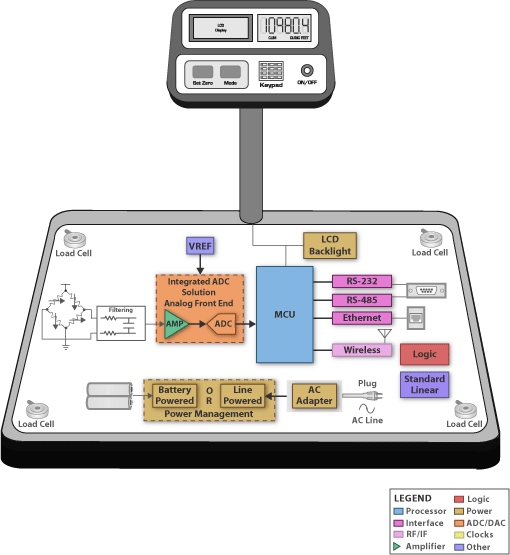
Weigh scales have wide range of uses in industrial, commercial and consumer applications. Electronic weight scales design is based on using a load cell as the primary transducer. Load cell designs can be distinguished according to the type of output signal generated (pneumatic, hydraulic, electric). Strain-gage load cells convert the load acting on them into electrical signals with the output in range of mV/V. The signal chain has to handle the small signal accurately in presence of noise. The signal then has to be processed for non-linearity, temperature dependency and offset errors and drifts. Hence the signal chain consists of appropriate excitation technique, signal conditioning, signal acquisition and processing and interface and communication.
Excitation Technique: The sensor needs an accurate and a highly stable excitation source. Many pressure sensor designs use the same common reference for the excitation circuitry and the ADC for better accuracy and the thus the sensor output is ratio metric. TI's Reference Voltages provide cost effective solution for the mentioned requirements with high initial accuracy and extremely low temperature drift.
Signal Conditioning: In most Load cells the output range of a strain gauge is very small and thus the signal needs to be amplified before processing to prevent introduction of errors. TI provides a wide selection of Low Noise Amplifiers with high CMRR and high gain at low frequencies suitable for the small signal output of the sensor. Additionally, since the signal bandwidth is low, the 1/f noise of the amplifiers can introduce errors. TI's Chopper-stabilization amplifiers provide extremely high dc precision and noise performance at low frequency range.
TI has highly efficient solutions tailored for Weigh Scale application. They comprise of precise, low-drift programmable gain instrumentation amplifiers with high common mode rejection ratio and proprietary auto-zero techniques.
Signal Acquisition and Processing: TI's high resolution differential ADCs have low temperature and offset drifts required for Weigh Scale application before it is sent to a MCU. TI's MSP430 series of microcontroller can be used to perform calibration and compensation in addition to using the on-chip data converters for data acquisition. It also provides functions including calculation and signal processing, friendly user interface such as LCD display and key pad control, and wireless/wired data transfer and connectivity interfaces.
Interface and Communication: Traditional RS-232/RS-485 interfaces remain popular choices for weigh scale application. Special application based weigh scales include wired options of Ethernet or USB connectivity and wireless options based on IEEE 802.15.4 protocols. TI is committed to provide solutions for both traditional and emerging communication interfaces.
Power: The Weigh Scale can be Line Powered (AC Mains supply) or Battery Powered. TI’s power management portfolio includes LDOs, DC/DC converters and buck boost regulators giving flexibility to the user to configure a power solution that meets the system requirements. TI's low quiescent current LDOs have excellent line and ultra-fast load transient performance. The DC/DC buck converters offer over 95% efficiency over a wide battery voltage range, even with input voltage down to 1.8 volts extending battery life. Special Buck-Boost converters generate a stable required output voltage and supply constant current for over- and under-input voltage conditions and support various battery configurations.
Click here for solutions guide
Download Full Block Diagram Below
Advertisement

Learn more about Texas Instruments





